
Palazzo Tirelli (formerly Gabbi) is a former aristocratic palace located on Via Gabbi #16 in the historical centre of Reggio Emilia, Italy.


Palazzo Tirelli (formerly Gabbi) is a former aristocratic palace located on Via Gabbi #16 in the historical centre of Reggio Emilia, Italy.

A palace at this site was originally built was built in the 17th century as the residence for the marquises Gabbi. In the beginning of the 19th century the palazzo was sold to the aristocratic Tirelli family; in 1970, they sold a part of it to a club called Società del Casino, that at present still owns it. The rotary club of Reggio also has its head office on the ground floor.
The grand staircase leads to the rooms of the first floor decorated with stucco and frescos of the local painter Prospero Zanichelli. The biggest room, 13 metres high, is decorated with frescos and 8 paintings that represent Homeric scenes, by Francesco Vellani from Modena.
There is a Palazzo Tirelli in Parma.

Reggio nell'Emilia, usually referred to as Reggio Emilia, or simply Reggio by its inhabitants, and known until 1861 as Reggio di Lombardia, is a city in northern Italy, in the Emilia-Romagna region. It has about 171,944 inhabitants and is the main comune (municipality) of the province of Reggio Emilia.

Niccolò dell'Abbate, sometimes Nicolò and Abate was a Mannerist Italian painter in fresco and oils. He was of the Emilian school, and was part of the team of artists called the School of Fontainebleau that introduced the Italian Renaissance to France. He may be found indexed under either "Niccolò" or "Abbate", though the former is more correct.

Alessandro Barbero is an Italian historian, novelist and essayist.

The Pietra di Bismantova is a geological formation in the Reggiano Apennines, in the comune of Castelnovo ne' Monti, province of Reggio Emilia, Northern Italy, c. 45 kilometres (28 mi) from Reggio Emilia. It has the shape of a narrow, quasi-cylindrical plateau whose steep walls emerge 300 metres (980 ft) as an isolated spur from the nearby hills. The top has an elevation of 1,047 metres (3,435 ft) above sea level. It is included in the National Park of the Appennino Tosco-Emiliano.

Bruno Ceccobelli is an Italian painter and sculptor. He currently resides and works in Todi, Italy. Ceccobelli was one of the six artists of the Nuova Scuola Romana or Scuola di San Lorenzo, an artistic movement that grew out of the Arte Povera and Transavanguardia movements of the latter twentieth century.
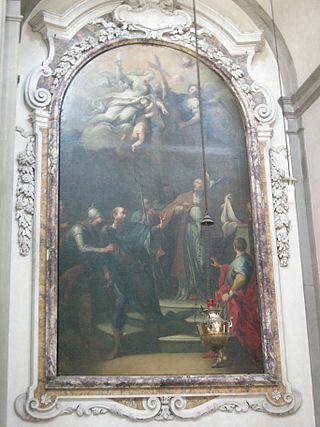
Francesco Vellani (1688–1768) was an Italian painter, active in Modena in a late Baroque style. He mainly painted sacred subjects.
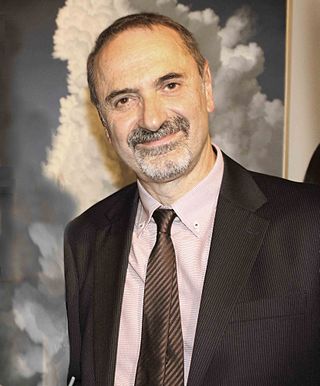
Alberto Bertoldi is an Italian painter.
Luciano Caruso was a poet, visual artist, critic, journalist and writer. He was born in 1944 in Foglianise, a region located in the mountains of Sannio, Italy. He grew up and lived in Naples until 1976. After this point, he moved to Florence. He graduated in Medieval Aesthetics, with a thesis on carmina figurata. While in Naples he was also the editor of many magazines of the avant-garde, among them Linea Sud, Ana etcetera, Continuum, Uomini e Idee, Silence's Wake, E/mana/zione etc....
The following is a timeline of the history of the city of Ferrara in the Emilia-Romagna region of Italy.
The following is a timeline of the history of the city of Ravenna in the Emilia-Romagna region of Italy.
The following is a timeline of the history of the city of Parma in the Emilia-Romagna region of Italy.
The following is a timeline of the history of the city of Reggio Emilia in the Emilia-Romagna region of Italy.
The following is a timeline of the history of the city of Reggio Calabria, Italy.
The following is a timeline of the history of the city of Trento in the Trentino-South Tyrol region of Italy.
The following is a timeline of the history of the city of Forlì in the Emilia-Romagna region of Italy.

The Torre dell'Orologio is a 15th-century renaissance tower on the Piazza delle Erbe in Mantua, Italy. It is attached to the Palazzo della Ragione, and next to the Rotonda di San Lorenzo. It houses an astronomical clock.
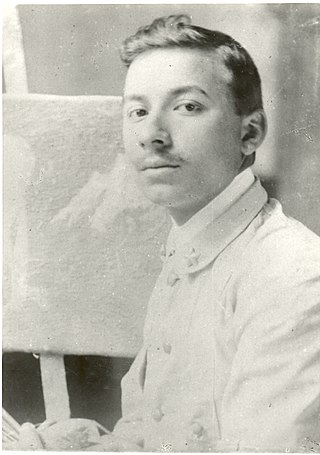
Giuseppe Graziosi was an Italian sculptor, painter and graphic designer.
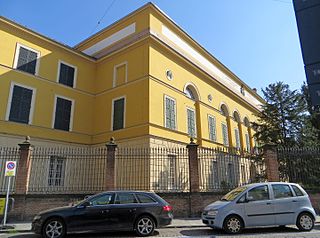
The Convitto Nazionale Maria Luigia, once known as the Collegio Ducale Maria Luigia, is a state school located on Borgo Lalatta 14 within the grounds of the Palazzo Imperiale dell'Arena in Parma, region of Emilia-Romagna, Italy.
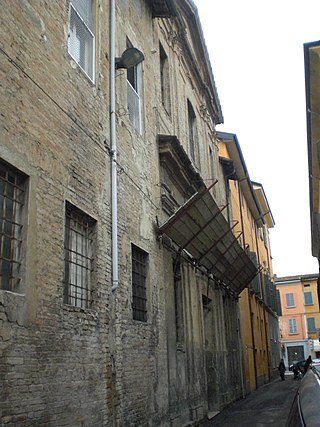
The Oratory of San Spiridione is a small Baroque-style church or chapel located on Via Nuova in the historic center of Reggio Emilia, region of Emilia Romagna, Italy.
Pietro Marchelli was an Italian architect active mainly around Reggio-Emilia.
{{cite book}}: CS1 maint: location missing publisher (link){{cite book}}: CS1 maint: location missing publisher (link){{cite book}}: CS1 maint: location missing publisher (link){{cite book}}: CS1 maint: location missing publisher (link)44°41′52″N10°38′10″E / 44.69778°N 10.63611°E